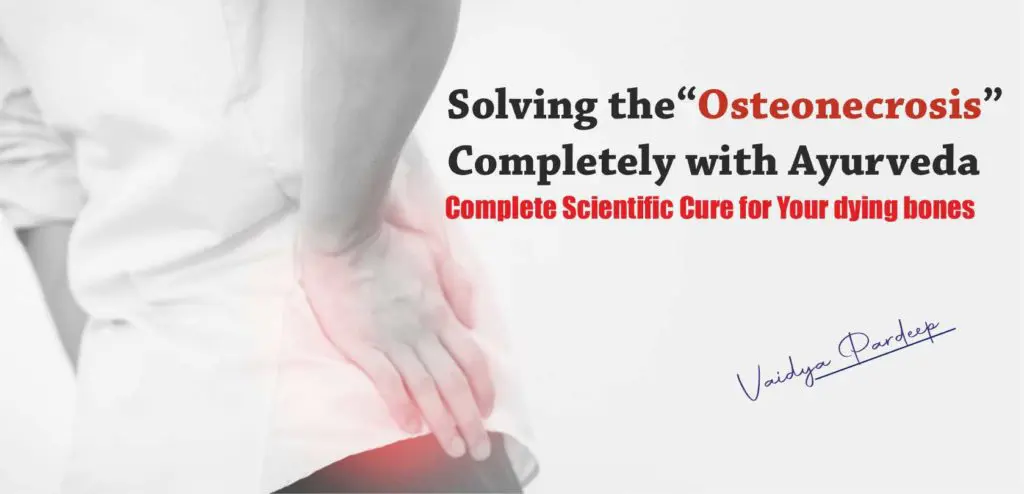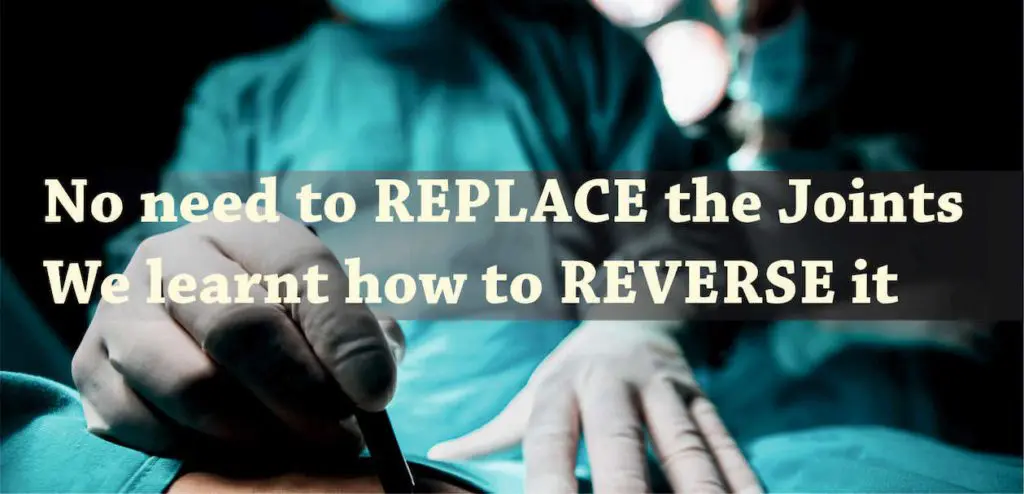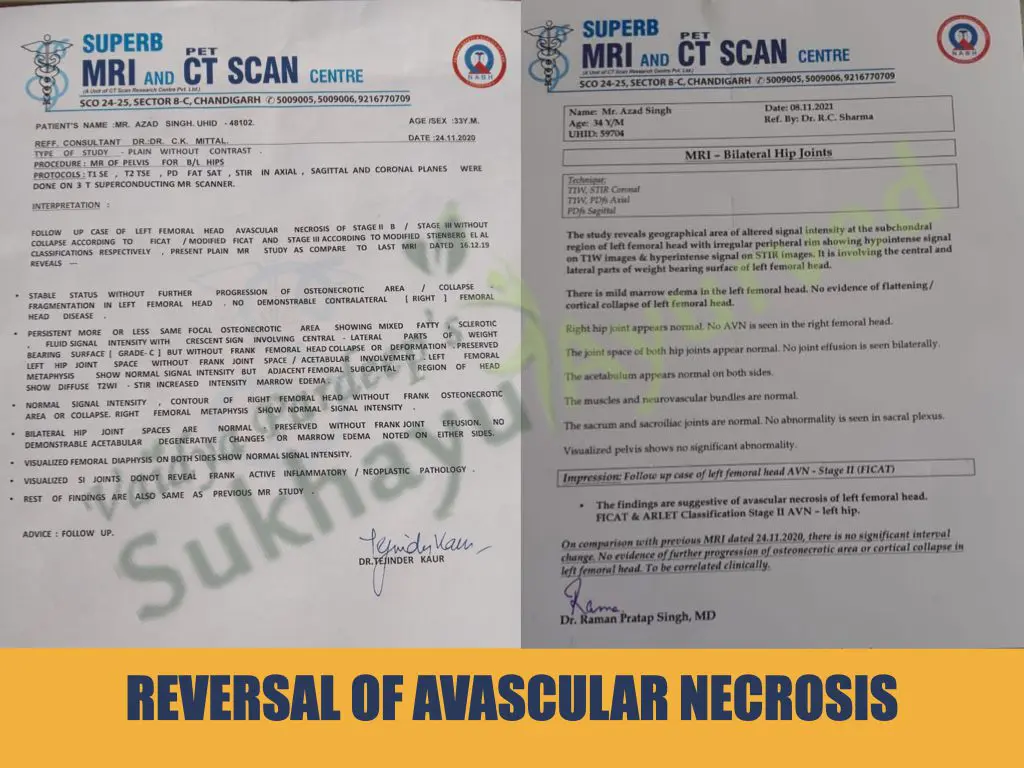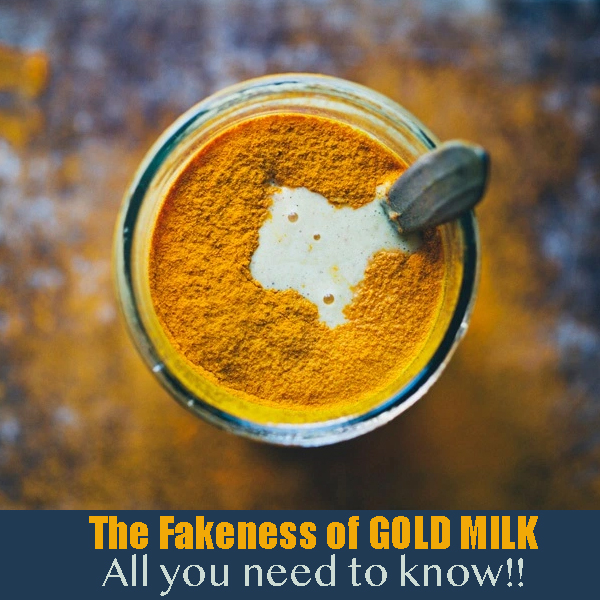Reversing Osteonecrosis with Ayurveda: A Scientific Approach
Osteonecrosis, also known as “bone death”. This is a serious medical condition in which the bone tissue dies due to the loss of its blood supply. Since the entire purpose of the marrow inside bones is to provide them with ample support and nutrients via these blood vessels. This complete loss of this essential tissue can be life-threatening. At Sukhayu Ayurved we offer complete Ayurvedic treatment for osteonecrosis and ensure complete avoidance of total hip replacement.
At Sukhayu Ayurved we don’t –
- Pull and apply traction on the patients.
- Cup and cut to ooze the blood.
- Ask patients to do “strange” exercises.
Under Vaidya Dr. Pardeep Sharma‘s guidance, with experience of more than 20 years, we have higher goals for the treatment of Avascular Necrosis.
- We aim to restore the blood supply to the affected bone.
- We heal the bones.
- At Sukhayu Ayurved we don’t just “delay” the osteonecrosis- we work on complete avoidance of hip replacement.
- The main aim of treatment is to reverse process of the disease.
These four points, which we follow at Sukhayu, are based on the scientific exposition of the problem.

Avascular Necrosis aka Osteonecrosis
Like all diseases, osteonecrosis has numerous different causes that lead to the same end results within once healthy tissues.
When this condition occurs in one or more specific bones throughout the human body. It’s referred to by several different names including avascular necrosis (AVN), aseptic necrosis, and ischemic bone necrosis.
Patients are usually only diagnosed with Avascular Necrosis after the progress of the disease. Patients visit the doctors only after sudden pain or tenderness in some area of their body. The pain does not seem to be the source of any other medical problems.
When bones expose to extremely high levels of trauma. It’s common for them to suffer from several different injuries. These include fractures (breaks), dislocations, and/or contusions (bruising).
While most types of bones are able to heal themselves over time without causing any long-term damage. Others such as femur heads may not be able to do this very well if their blood supply reduces drastically.
Even when Osteonecrosis occurs due to physical injuries like these. However, most cases still begin with the gradual onset of strange symptoms instead of sudden pain after an accident.
The cases of Avascular necrosis are rising after the coronavirus outbreak. These cases are complicating with the time and post-covid avascular necrosis should be taken seriously by everyone.
What Causes Osteonecrosis of the Hip?
Osteonecrosis typically occurs in adults who are in their mid-to-late thirties. It’s also more likely to affect people in this age group even without any traumatic injuries to the affected area. The medical community is currently uncertain like in many other diseases.
As to why some people develop Avascular Necrosis during their prime years while others do not.
Everyone who takes alcohol and steroids doesn’t lead to Avascular necrosis. This is because of the dynamic nature of the body, which is hard to predict.
But it seems that certain risk factors may determine whether or not someone will actually get it. Based on what happened within their past.
Some of these risk factors include having an underlying health condition that increases your chances of developing Osteonecrosis (such as HIV). Using medications like steroids that promote bone death. And/or having some sort of internal trauma like a car accident. Or even smaller injuries that aren’t severe enough to cause Osteonecrosis by themselves.
It is currently unknown whether certain dietary factors may contribute to the development of this disease. Among those who are already genetically predisposed to get it. But many medical professionals suspect that there’s a strong link between estrogen levels and bone health. The same link also plays a role in its onset. Most people will only receive a proper diagnosis after the progress of the disease. Like in grade II or III minimum. Even though their actual condition was present long before it worsened to such an extent.
What does Avascular Necrosis Look Like?
The skeletal system can be compared to body scaffolding since bones provide the foundation for your entire physique. Like these metal supports, however, you need to make sure that they’re in good repair at all times in order to avoid injury or sudden collapse. When an area within the skeletal system deprives of its life-giving blood supply. It’s usually due to either physical trauma or an underlying health condition like cancer which causes Osteonecrosis by itself.
When this happens, various areas throughout different bones will become inflamed. And gradually start dying off until everything within them eventually becomes useless. With time, these dead tissues eventually absorb back into the body. So that it can use what’s left of its minerals for other things including new bone growth. Patients who have experienced bilateral femoral head Osteonecrosis will often find this degeneration starting from the hip. And this spreads all the way down to their knees.
What Are the Symptoms of Osteonecrosis?
While AVN doesn’t typically occur until you’re well into adulthood. Doctors now know that it’s just as common as many other orthopedic conditions such as avascular necrosis (AVN) and aseptic necrosis. People with a diagnosis of Avascular Necrosis show signs of similar symptoms within both hips at roughly the same time. This helps medical professionals confirm what type of condition they may be dealing with. Instead of mistaking it for something else. Some common signs and symptoms associated with this disease include:
– – Pain and tenderness within the hip and groin (usually severe)
– – A clicking or popping sensation near the affected area (often indicating some sort of dislocation)
– – Swelling and/or redness within the skin
– – Changes in skin pigment around an affected area. Especially if it exposes to excessive sunlight as a result of its new positioning.
As you can see, Osteonecrosis usually begins with subtle symptoms that become more pronounced as time goes by. It is also very likely for those living with this condition to go on without showing any obvious signs at all. Until they’ve experienced a large amount of pain and stiffness within their hips and legs. However, once you reach this point there’s no going back since your bones have already started to weaken and collapse.
Is There a Cure for AVN?
Even though this condition can be very painful and debilitating. It doesn’t associate with a high rate of mortality. In the event that you find yourself with Osteonecrosis within your hip area.
Doctors will likely recommend a total hip replacement as a type of intervention. To avoid permanently damaging your legs and hips. While this approach does provide those living with AVN with some level of relief from their symptoms. It doesn’t actually treat or cure what’s causing their disease in the first place.
Based on recent studies administered at Sukhayu Ayurved (an integrated health clinic located in India). We now know that Osteonecrosis is nothing more than an outcome of blocked capillaries and arteries along with weak bones.
The treatment process focuses on bringing oxygen-rich blood to the bones. This helps to reverse this condition at its core. This also means avoiding the replacement of all affected areas. This type of holistic approach has helped thousands of people living with Avascular Necrosis avoid undergoing a painful and expensive hip replacement surgery that only provides temporary relief anyway.
Why Hip is More Susceptible to Osteonecrosis?
As mentioned earlier, severe cases of osteonecrosis can be found in several different areas throughout the body. However, it seems to occur most commonly around the hip joint due to its position as a weight-bearing surface. And the high amount of stress being placed on it during daily activity. These factors cause a lot of pressure through the femur head into the acetabulum portion of the pelvis. This may lead to AVN even if no trauma is involved.
In these cases, both hips typically get AVN over time. This condition occurs due to a chronic lack of blood flow rather than acute injury or illness. In some cases, however, only one hip might become affected due to an underlying health condition such as diabetes. This can result in a condition called “bilateral femoral head osteonecrosis”. Where both the left and right hip joints have deteriorated severely from reduced blood supply due to clogged arteries.
Are you taking Calcium for bones?- A must-read for you: Calcium: Myths vs Facts
Why Modern Medicine is failing to treat Avascular Necrosis?
There are certain reasons which turned osteonecrosis into an incurable condition of the bones.
Lack of Willingness About Avascular Necrosis
Surgery is a huge market. Surgeons make millions in revenue which is why they are not interested in finding the root cause for this condition. If you can’t make money out of it, no one will go deep into looking for the reasons behind Osteonecrosis. The money-centric medical practice only focusing on joint replacement. Because, after joint replacement, the patient is trapped within the vicious cycle of the surgeries and correction surgeries.
Lack of Pathological Understanding of AVN
Osteonecrosis destroys the bones, kills bone tissue but this is not a disease of the bones itself. The main problem is the blood supply to the bones. AVN is a disease of bad circulation in which oxygen-rich blood does not reach the bones, stems from the clogged arteries. This is a deviation from the cause. Thus there are no results in the treatment of avascular necrosis with modern medicines.
No Focus on Rejuvenating Therapies
Patients can’t afford these therapies with their insurance companies so they are forced to go for surgery all over again. Osteonecrosis treatment with the help of rejuvenating therapies and nutraceuticals is what we suggest. We use lifestyle changes, food supplements, and herbs to reverse this condition
No focus on the root cause
Patients are told to go for total hip replacement surgery when they have AVN in their hips. There is no effort from the medical field about preventing avascular necrosis from affecting other bones or joints in the future. This is a big reason why people need more than one joint replaced till now.
Destruction of Research Data
If someone starts digging through data, they would end up knowing that surgery wasn’t the answer to this disease. Even when surgeons know that surgery isn’t a cure but still recommend it to patients then definitely there is something fishy inside. This has happened way too many times with Osteonecrosis. And hence our ability to find any cure hinders by lack of willingness and destruction of research data.
We follow an integrated approach that aids patients in avoiding further surgeries while also providing a healthier oxygen flow within their body’s blood vessels so that nutrition can reach their bones which will not allow you to have any AVN.
We are the only clinic in India that offers this approach to patients suffering from Osteonecrosis.

Ayurvedic Treatment for Osteonecrosis at Sukhayu Ayurved
Sukhayu Ayurved provides a four-step treatment for Avascular Necrosis. The treatment for AVN helps to open clogged arteries, increase blood supply to the bone marrow, restore new bone growth by reversing Osteonecrosis, and finally prevent the need for joint replacement surgery.
1. Opening clogged arteries with detoxifying herbs
2. Increase Blood flow of the affected area with nourishing herbs
3. Restore new bone formation of the affected area with nourishing herbs
4. Reverse Avascular Necrosis so no more damage occurs within bones.
Opening clogged arteries with detoxifying herbs
Ayurveda tells about the natural herbs, which help in cleaning the impurities of the blood and improves blood supply. The main one among these is- Guduchi/Giloya – Tinospora cordifolia. We have developed wonderful medicines- Powder Ossium and Cap Ossium-8 for the bones from high-quality Giloya Sattva. Improving blood supply to the bone marrow, where stem cells are present.
Ayurvedic medicine for Avascular Necrosis
When taken with freshly prepared- Mahamanjisthadi Kashayam. These two medicines (Ossium) help in opening clogged arteries. Therefore, help in the reversal of pathology of the Avascular Necrosis. It gives the complete possibility of the Ayurvedic cure of AVN.
Increase Blood flow of the affected area with nourishing herbs
This we do through herbs like Manjistha and Giloya, Guggal. We use this for a long time and we will see the results in the form of pain relief and reduction in swelling. These all come together in form of different preparations. The Ossium powder and capsules along with Mahamanjisthadi kadha helps in this process.
The main thing is reducing the swelling along with opening the clogged arteries. And this all should go hand in hand, everything at the same time.
Restore new bone formation
Panchakarma plays an important role in this process. Panchakarma helps in the process. When we need the primary metabolites to work, we need to make these available to the body. This is possible with Panchakarma only.
The fat-based medicines help in this healing process while doing Panchakarma. Now it is well proven that fat cells are more skilled in bone development. This relates to the explanation of Ayurveda about Dhatus. For Ayurveda Medo Dhatu (adipose tissue) is the precursor of the Asthi (bone). This Vedic wisdom helps in the complete recovery of the patients. Modern medical research also proves the link between fatty tissue of the body and bones.
Sukhayu Ayurved prevents hip replacements at all costs. Because this is not just about reducing pain or order mobility but it’s about healing your bones completely. Hip Replacement is never good. This can be avoided by going through our Ayurvedic Treatment for Avascular Necrosis.
The Science behind Ayurvedic Treatment of Osteonecrosis

There is a certain amount of remodeling that goes on in skeletal bones. Through bone resorption, the osteoclast cells remove some of the older bone tissue and release calcium into the bloodstream.
The body needs to maintain constant concentrations of calcium in our blood. So this process will only take place when needed. Calcium should remove from the blood somehow. Or else it may become very dangerous to have elevated levels of calcium in our blood.
Bone formation increases when there are high calcium concentrations in the body. This is because osteoblasts will increase bone production to reduce the amount of free calcium in the bloodstream.
It does this by using the free calcium ions to create new bone tissue. If there are no elevated levels of free calcium in the blood. Then these osteoblasts will actually absorb some of the older worn-out bones. And finally, release small amounts of calcium into the bloodstream.
Bone Remodelling
Remodeling is a constant process that goes on all the time in skeletal bones. Even if we don’t really feel any pain or discomfort.
However, if a bone breaks due to a traumatic impact. Then sets off a series of events that lead to the above process taking place inside of the body.
It’s as if our bodies sense that some harm has been done to the tissues. As a result, more calcium needs to flush out from the bloodstream as quickly as possible.
This is the result of tiny vessels in brittle bones being torn apart by sharp fragments or broken ends that are forced into adjacent tissue. The red blood cells start to clot around these fragments and form a hard, irregular structure called a hematoma sac. Since this clotting process takes place quickly. There is less likelihood of damage to nerves and tissues near the fracture site.
There will be some internal bleeding in this initial stage but it’s usually not enough to cause major problems. Therefore, bone healing itself can begin very soon after the injury occurs. This allows faster healing times than most people realize.
These tiny bone fragments may sometimes break off during an impact because they were already somewhat weakened by osteoporosis.
Bone Repair Process
As mentioned earlier, there are different stages that occur during the healing of a broken bone. The first stage is – hematoma formation. This involves bleeding at the site of injury.
This initial bleeding may continue on for up to two hours since blood vessels in bone tissue have extremely slow blood flow rates. Due to their rather non-elastic properties. Hematoma formation follows by the recruitment of bone-forming cells to the area.
These are usually various types of osteoblasts that come in from nearby areas. This dissolves some of the old bone tissue. This creates new cortical bone tissue before the hard calluses forms around the fracture site.
It takes about three months for these initial stages of bone repair. After which time most people are able to resume normal activities without any problems whatsoever.
Helping the process
This is where most doctors begin to get things wrong with their prognosis. They simply expect you to start walking on a broken leg right away instead of giving it time for healing first!
It’s really not that big a deal if you need crutches or a cane for help during this period of time. In fact, you’ll get a lot more healing done if you don’t put too much stress on the fracture site.
Know about: Diet for Avascular Necrosis
When bone repair is complete, there will be a thin layer of scar tissue covering up the fracture site itself. This new tissue can formulate after a few weeks. Its color stands out from the normal white appearance of normal bone. While this process takes months to happen, these tiny fractures can sometimes heal in days or weeks depending on how serious they are and how fast your body responds to them with its self-healing capabilities.
Know about Dhatus
How does Osteonecrosis impact the bone repair process?
In cases where osteonecrosis occurs near a fracture site, the break will heal up just fine without any problems. However, it’s not unusual for late-stage patients to have developed a bone tumor or cyst at the fracture site due to a lack of blood flow through the tiny capillaries that feed these areas with nutrients and oxygen.
This is usually caused by small fragments of calcium that deposit within blood vessels over time. Effectively “plugging them” and starving tissues around those areas from much-needed supplies.
Even if this complication was not present during the original injury, it may still develop months down the road as a result of reduced blood flow rates through those now calcified vessels. In fact, this seems to be one of the more common reasons for bones dying back after an injury.
While this is not necessarily a permanent condition, it may require that the fracture site be treated by some other method than just allowing it to heal naturally.
If osteonecrosis has occurred due to some underlying health condition such as diabetes, there’s no way of knowing if or when these tiny vessels might suddenly become blocked with yet another calcified blood clot.
Bone marrow and osteonecrosis
Most bones and bone cells exist primarily due to the presence of a soft, spongy material inside them called “marrow”. This is where new bones are created by osteoblasts that live within this tissue. The reason why blood vessels cannot penetrate into these tissues is that they contain large numbers of red blood cells.
In cases where a bone has died back from having too little blood supply. It’s possible for marrow spaces to start being filled up with fatty tissue instead of leaving empty holes inside the long bones.
While this does not necessarily lead to any health complications beyond aesthetics. It can impair proper restoration of normal bone height in some cases. In worst-case scenarios, these spaces are filled with calcium deposits that often result in accelerated bone growth.
This can lead to bones being pulled apart over time.
Since they are now held together only by the most narrow portions of dead marrow space. Instead of having healthy living tissue holding them together. Eventually, they may collapse into a pile of loose-boned fragments. This results in an even more severe deformity than what was originally present at the time of injury.
The Science Beyond the Shastra
Amazingly, some patients have actually been able to go through their entire lives with this kind of underdeveloped skeletal structure without any serious health problems related to it whatsoever! It doesn’t seem possible for this degree of poor development to be caused by anything other than decades worth of reduced blood flow rates within the long bones, which would have deprived them of the crucial supply of nutrients within these red blood cells.
The Sukhayu Ayurveda hospital is a world-class facility. This place provides people living with AVN the ability to heal without the need for surgery. Our doctors use special techniques that carefully restore bones and joints. While preserving as much healthy tissue as possible from within the affected area. In addition, we also offer our patients a combination of rejuvenating therapies so they feel stronger, more flexible, and energized than ever before after completing their treatment of Avascular Necrosis.
If you have any questions about how we might help you or someone close to you live a better life, please don’t hesitate to contact us today! You can reach us via phone or email during normal business hours and we’ll be happy to answer any of your questions or provide any additional details that will help you decide if our treatment plan is right for you.
Contact Details: Sukhayu Ayurved Treatment Center
#1320, Omaxe City, Phase-II, Ajmer Road, Jaipur- 302026
Tel. +91-9050802060, 9828925257
Email: [email protected]
Web: www.sukhayuaerved.com
Facebook Page: https://www.facebook.com/SukhayuAyurved/
YouTube Channel: https://www.youtube.com/channel/UCPgLUyRS6zKc4












4 comments